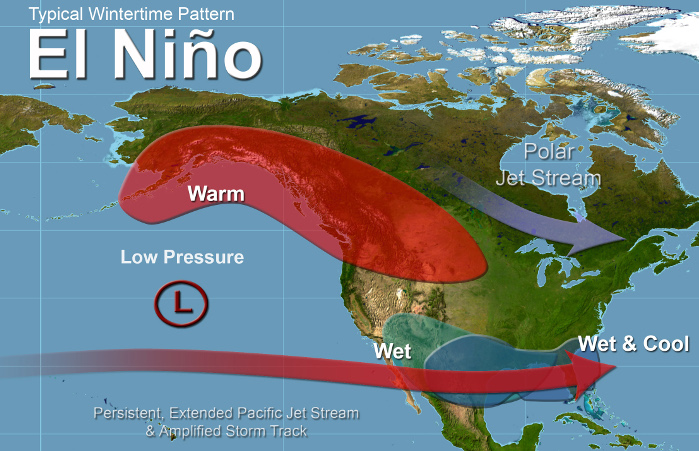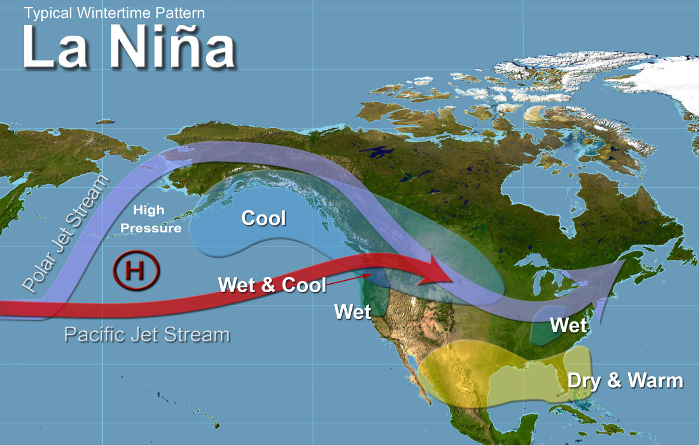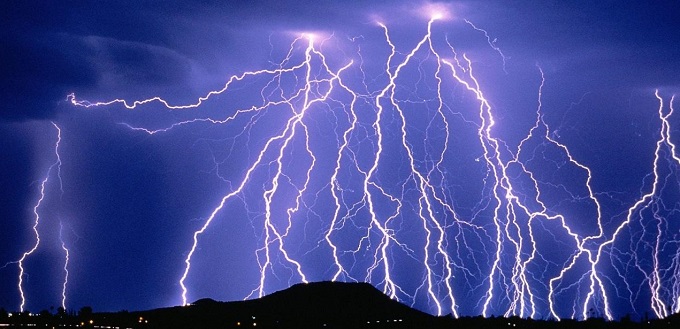North American weather varies widely and entirely dramatic. It is because of the prevailing weather patterns that influence the climatic conditions of the landscape. North America has everything from Arctic cold to Equatorial heat. These weather patterns create climatic changes like tornadoes, storms, monsoon abnormalities, warmer climate, extremely cold climates and much more.
These typical climate patterns and their impact are not known to many people. In this post, I’ll share brief information concerning the conventional methods, their harmful effects on human health, and some actions you can take to avoid those consequences.
Weather Patterns
El Niño and La Niña are the most common weather patterns that mostly affect North America. These cycles come alternately every five years and profoundly change the weather conditions of the entire continent. They are the two different phases of El Niño Southern Oscillation, commonly known as ENSO, an abnormally periodic variation in sea surface temperatures and wind, mostly over the tropical eastern Pacific Ocean, much affecting the tropics and subtropics.
El Niño

El Niño is the warm phase of ENSO. It’s related to a warm ocean band that forms in the east-central equatorial Pacific when the winds fail to replenish after the summer monsoon of Asia. The conditions of El Niño are seen between Junes to December. El Niño has the most significant impact on the weather of the North American landscape. Here are some of its effects;
- Mild winter temperatures over the northwestern USA and western Canada, resulting in the lesser snow.
- Drier than the average condition in Pacific Northwest and Ohio, leading to droughts.
- Above-average precipitation at the Gulf Coast, including Florida, which might lead to severe flooding in the states.
The effect of El Niño is mostly unpredictable, like a child. It’s sometimes less efficient and some years are too severe, causing numerous natural disasters.
La Niña

La Niña is just the opposite of El Niño. It’s also called the cold phase. During the La Niña period, the sea surface temperature across the Equatorial Eastern Central Pacific Ocean gets lower than average temperature by 3 to 5 °C. The effect of La Niña in North America is far-reaching. Some of its impacts are;
- Temperatures are above average in the southeast part of the North American region, and below average in the northwest, resulting in abnormal summer and winters.
- Minimized convection in the Pacific that leads to a weaker jet stream.
- Conditions get more favorable for hurricanes in the central Atlantic area and the Caribbean, resulting in many stronger-than-average hurricanes in the regions.
- Winds along the Equatorial region get stronger, especially in the Pacific, leading to freezing winters.
- Instances of tornados are greater in the states of the US already vulnerable to tornadoes.
It also results in Tehuantepecer, intense and violent wind. Severe droughts and over flooding might also occur, depending on the severity of the conditions.
Effects of Weather Patterns on Health
The climatic variability due to the weather patterns can lead to various problems. Human health is most affected by the adverse effects of the impact caused by them. Here are a few examples of how our health is being affected;
Introducing New Infectious Diseases
Transmission of various infectious diseases is increased due to the abnormalities in the climatic conditions. Due to the weather patterns, in some areas, there is the extended rainy season, and some have severe droughts, introducing new climates to various regions, which are favorable for many vectors to survive and breed, adding new types of diseases. Humans are growing more vulnerable to unknown diseases.
Higher Risk of Malaria
Higher temperatures due to El Niño at the highlands can increase the risk of malaria transmission. In some areas which lack rainfall and humidity during the off weather patterns, most of the population of that regions lack immunity to such diseases, which can cause a severe malarial epidemic if irregular rainfall and humidity are caused due to the climatic changes. In fact, in some areas already prone to malarial parasites, the risk of an epidemic is increased by 5 to 10 times, which can wipe out half of the population of that region.
Toxicity in Sea Food
Warmer ocean temperature mostly results in toxic algae blooms or red tides. Due to flooding, the runoff water infiltrates the coastal seawater, increasing the amount of nitrogen and phosphorus. The algae feed on these and their population doubles. These toxic blooms, in turn, infect the shellfish. People dwelling on coastal areas feeding on the infected shellfish are affected by the toxicity. Paralytic shellfish poisoning is one of the most common consequences of red tides. Also, Ciguatera fish poisoning is caused by red tides. Humans get ill by ingesting these infected reef-dwelling fish. These toxic algae blooms are so poisonous that it can cause respiratory illness if one breathes near them.
Cholera Outbreaks
When the nitrogen and phosphorus levels in the ocean increase, the cholera bacteria that live within zooplankton of the ocean become active. As the wind blows, and along the ocean currents, the zooplankton carrying the active cholera bacteria is swiped towards the coastline. Due to flooding, the cholera bacteria infiltrate drinking water system, resulting in cholera outbreaks.
Other Effects
Abnormal precipitation and humidity also result in various other mosquito-borne diseases like dengue fever, elephantiasis, rift valley fever, and yellow fever.
Severe droughts affect the crop cultivation, which leads to less harvest, ultimately increasing the rate of bread and edibles. Poor people suffer from malnutrition as they are unable to buy a sufficient amount of food.
Tornadoes and cyclones also bring much effect to human health. Many suffer injuries, and some even lose their lives. With physical health, mental health is also affected by the shock, due to circumstances.
Measures to be Taken
Forecast Weather Regularly
We must keep ourselves up to date, not only about the current weather but also about the weather patterns and future warnings of any disaster that is likely to occur. We should also keep our family and friends alert.
Research and Learn
Do more research, and learn about the potential damages caused by the weather patterns. This way we can avoid some diseases, such as red tide toxicity or cholera outbreaks.
Maintain the Surroundings
We must keep our surroundings clean and healthy. There mustn’t be any water stagnation that could be breeding ground for mosquitoes.
Preparedness and Awareness
Tornadoes and cyclones can hit anytime. If you are living in vulnerable areas, always be prepared and make plans. This will help in surviving the worst disasters.
Educate the Public
Also, tell others about the warnings. Let them know the various impacts, and what can be done to prevent the effects. This way, everyone will be aware, and the epidemic or outbreaks can be avoided.
Conclusion
Weather patterns can bring drastic changes in the climate, and the worst part is, they are unpredictable and irregular. Abnormalities in the environment not only affect human beings but the whole ecosystem. Global warming is just worsening the impacts of weather patterns. Humans must be more aware of it before it’s too late.
